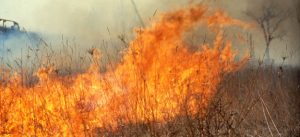Chapter 1: What is a Weed? Why Do We Care?
1.5 Indirect Costs
Now let’s examine some of the indirect costs of weeds. One common example is health problems or allergies that many people experience when weeds such as ragweed are pollinating. Another example of an indirect cost seen in pasture or grassland systems, is an increased risk for prairie fires. If you have a substantial weed infestation, this extra biomass can produce a lot of fuel. In dry conditions or late in the season, a single spark can create a large fire tragedy. Some weeds like brush or trees can have a high oil content, making the problem even worse.

Another indirect cost of weeds is that if they are tall enough, they can create a hazard at road intersections by obstructing drivers’ abilities to see oncoming traffic. In urban areas weeds can create aesthetic challenges when they grow through cracks in driveways and sidewalks. Over time their roots can create damage to these infrastructures.
We will learn more about invasive weeds later in this book. These are weeds which spread uncontrollably and when they invade river and stream ecosystems, they become even more unmanageable.
Review and Reflection